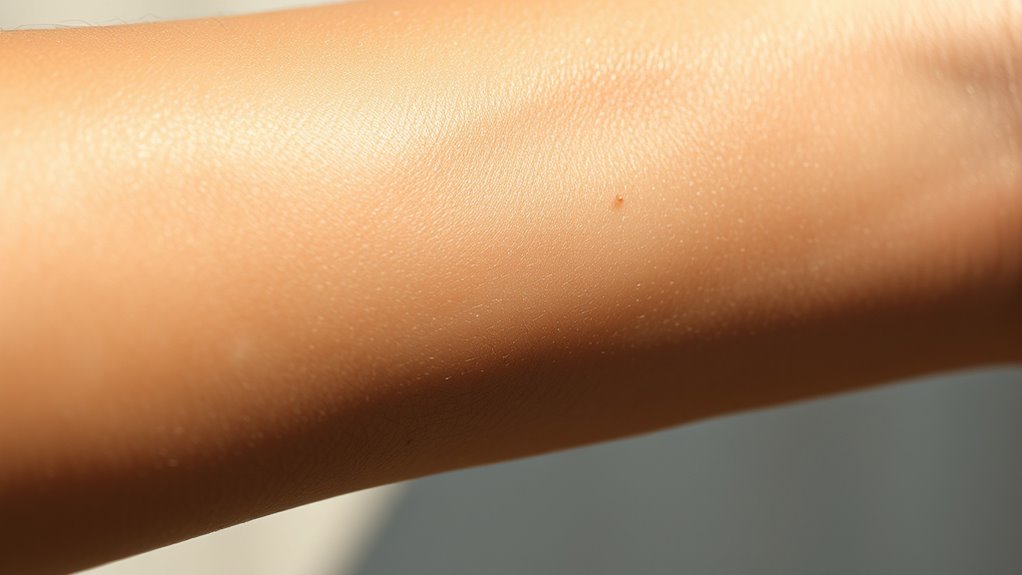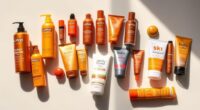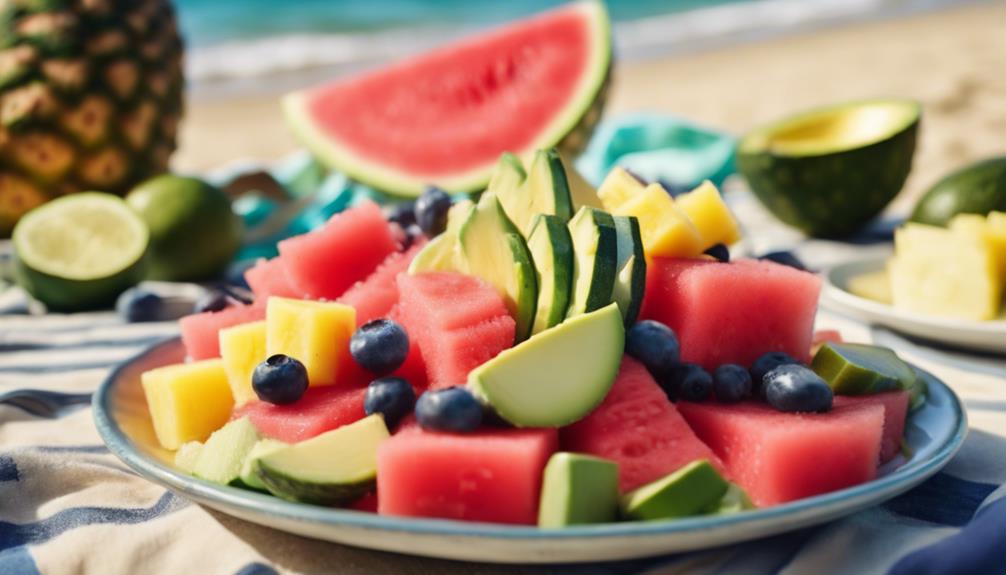Understanding your skin type helps you know how your skin reacts to sun exposure and how easily you can develop a tan. Using the Fitzpatrick system, you can identify whether your skin burns easily or tans well, based on melanin levels. Darker skin types tan more efficiently and resist burns, but all skin types should protect themselves properly. To learn more about how your skin responds and how to tan safely, keep exploring these important details.
Key Takeaways
- Skin type determines how easily your skin tans or burns, with darker types tanning more readily and lighter types burning quickly.
- The Fitzpatrick system classifies skin into six types, indicating melanin levels and tanning response.
- Higher melanin levels in darker skin provide some natural UV protection, but all skin types can be damaged by the sun.
- Lighter skin types (I, II) require more sun protection due to increased burn risk and limited tanning ability.
- Understanding your skin type helps tailor safe sun exposure practices and skincare routines to prevent damage.
The Fitzpatrick Skin Phototype System
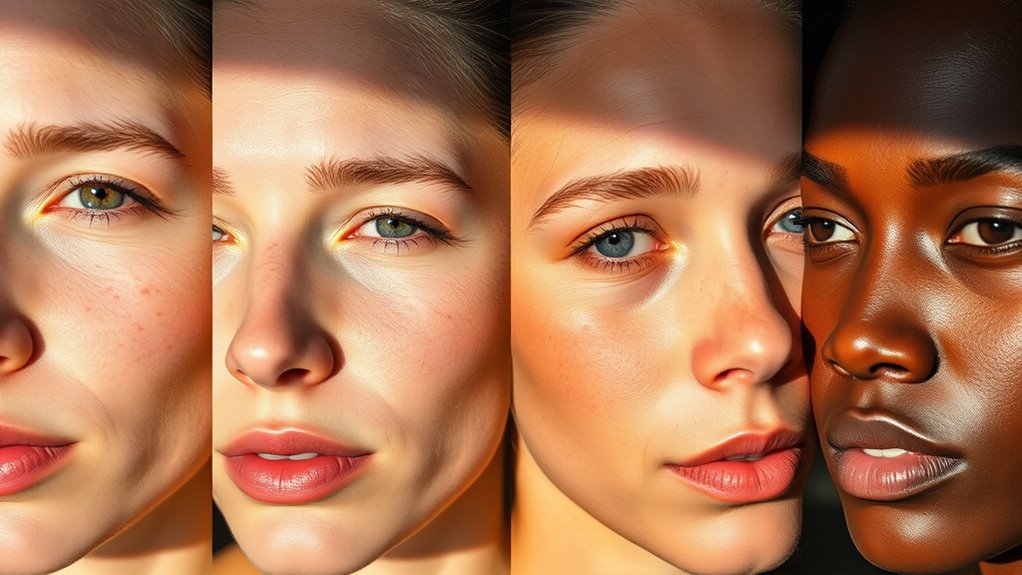
The Fitzpatrick Skin Phototype System is a widely used tool in dermatology that helps classify skin types based on their color and reaction to sun exposure. Developed in 1975 by Dr. Thomas B. Fitzpatrick, it groups skin into six types, from I to VI, based on melanin content and how your skin responds to UV radiation. Originally, it was created to guide UV therapy and minimize phototoxicity during skin treatments. Today, clinicians use it to assess your risk of sunburn and skin cancer, and to tailor sun protection strategies. The scale reflects increasing melanin levels and tanning ability, with Type I being very pale and always burning, while Type VI is dark, never burns, and tans easily. This system gives a clear framework for understanding your skin’s unique characteristics.
How Melanin Influences Skin Color and Tanning
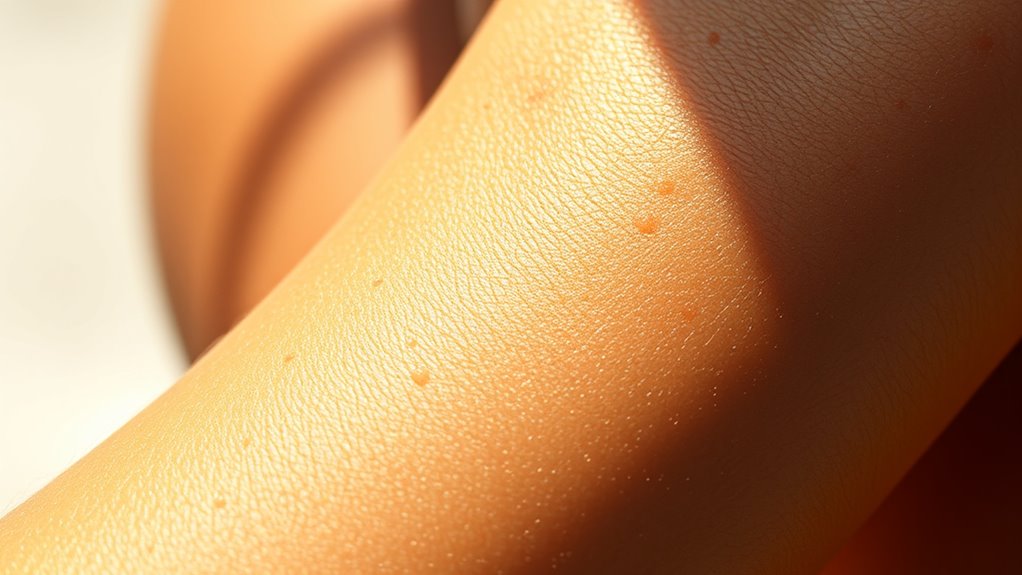
Melanin plays a central role in determining your skin color and how your skin responds to sun exposure. It’s produced by melanocytes, and the more melanin you have, the darker your skin appears. When you’re in the sun, UV rays trigger an increase in melanin production to protect your skin from damage. There are two main types: eumelanin, which gives a darker hue, and pheomelanin, which results in lighter tones. Genetics largely influence your natural melanin levels and skin color. While increased melanin can help shield your skin somewhat, it’s not foolproof. Tanning occurs as your skin produces more melanin to block UV rays, but this process has limits and can lead to skin damage if overdone. Additionally, understanding your beach experience can help you choose the appropriate sun protection and maximize your enjoyment while minimizing risks. Recognizing your skin type can further guide you in choosing effective sun safety strategies. Being aware of your melanin production can also help you better understand your skin’s unique response to sun exposure. This understanding is especially important as advancements in AI in Education encourage personalized health and wellness strategies. Incorporating holistic health practices, such as yoga, can support overall skin health and resilience against sun damage.
Tanning Capabilities Across Different Skin Types

Your skin’s ability to tan varies widely depending on your skin type, primarily due to differences in melanin levels. Generally, darker skin types tan more easily and resist sunburn better than lighter ones. For example, Type I skin burns quickly and rarely tans, while Type IV skin tans well with minimal burning. Types V and VI rarely burn and tend to develop a deep tan more readily. Melanin synthesis, stimulated by UV rays, plays a key role in this process, influenced by genetics and environmental factors. While all skin types can develop a tan, the amount of exposure needed and the resulting color differ considerably. Genetic factors significantly influence how efficiently your skin produces melanin and reacts to sun exposure. Additionally, skin response to UV radiation varies among individuals, making personalized sun protection important. Research also shows that individual skin variations impact how your skin reacts to sunlight and tanning ability, emphasizing the need for tailored sun safety measures. It is also important to note that sun exposure guidelines should be tailored to your specific skin type to prevent damage. The impact of UV exposure can vary based on skin type, underscoring the importance of appropriate precautions. Keep in mind that darker skin tends to tan more efficiently, but everyone should practice safe sun habits regardless of skin type.
Sunburn Risks and Protective Measures for Each Skin Type
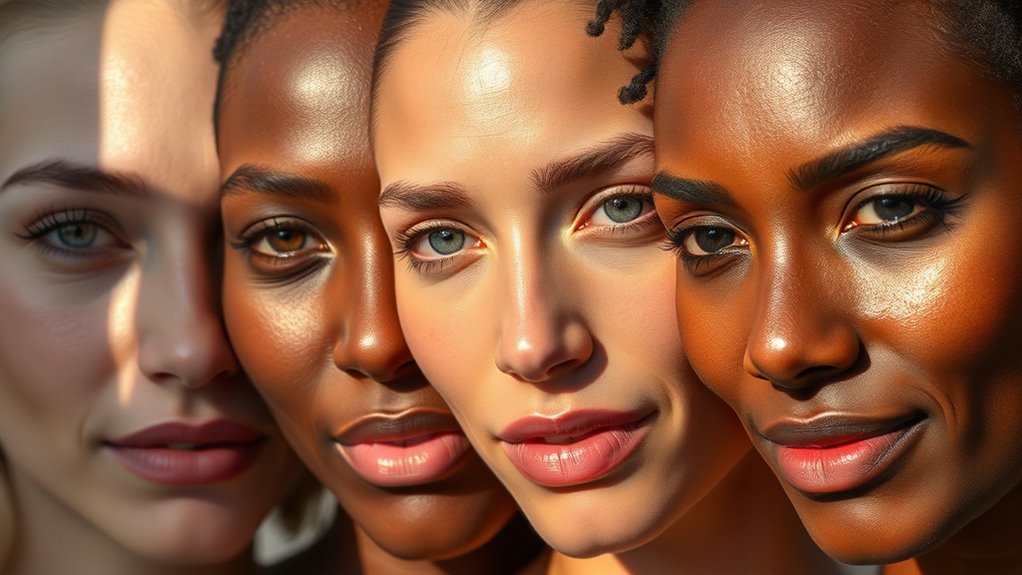
Different skin types face varying levels of sunburn risk, primarily based on melanin content. If you have very fair skin (Types 1 and 2), you’re at the highest risk, often experiencing redness, pain, and skin tightness after sun exposure. To protect yourself, use broad-spectrum sunscreen with SPF 30 or higher, ideally SPF 70 or 100, and avoid peak UV hours from 10 am to 4 pm. Wear protective clothing like long sleeves, wide-brimmed hats, and UV-blocking sunglasses, and seek shade whenever possible. For Types 3 and 4, the risk is moderate; apply sunscreen daily, wear protective clothing, and monitor your skin. While darker skin types (5 and 6) rarely show visible burns, they can still sustain UV damage—so always use sunscreen, cover up, and stay vigilant. Understanding water’s role in skin health can help you make informed decisions about sun protection and skin care. Additionally, incorporating energetic alignment techniques can enhance your overall skin health and resilience against UV damage.
Characteristics and Tanning Patterns of Specific Skin Phototypes
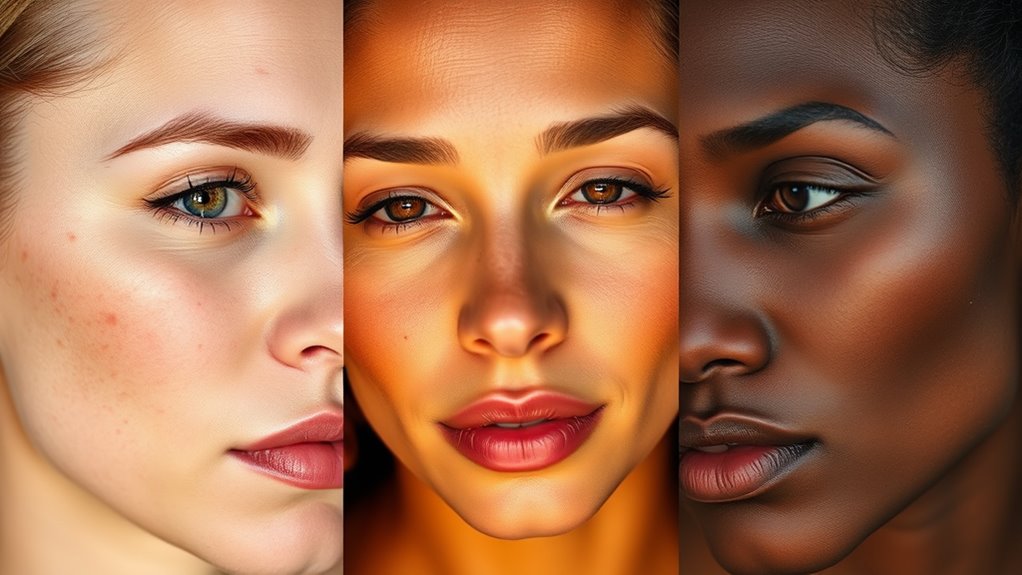
Understanding how each skin phototype reacts to sun exposure helps you better protect yourself. If you have Type I skin, your skin always burns and never tans, due to very low melanin. You’re highly sensitive to UV rays and need maximum protection. Type II skin burns easily and tans poorly, often after initial burning, with some melanin providing minimal protection. Type III skin sometimes burns but typically tans to a moderate brown after repeated exposure, reflecting a *gradual* response. Those with Type IV skin tan quickly and easily, rarely burn, and develop a uniform tan without significant damage. For darker skin types, V and VI, burning is rare or nonexistent. They tan deeply and profusely, thanks to high melanin levels, which naturally protect against UV damage. Understanding skin reactions helps you tailor your sun protection strategies effectively. Recognizing the role of melanin in different skin types can further inform your approach to sun safety. Additionally, being aware of tanning patterns can help you set realistic expectations and prevent skin damage.
Furthermore, awareness of how UV exposure impacts various skin types can guide you in choosing appropriate skincare routines and protective measures. Incorporating knowledge of skin response mechanisms can enhance your ability to prevent overexposure and skin harm.
Practical Tips for Safe Tanning Based on Your Skin Type

To tan safely, start with short exposure sessions tailored to your skin type and gradually increase their duration. If you have Type I skin, begin with 5-10 minutes, building up slowly after establishing a base tan. For Type II, start with 10-15 minutes and cautiously extend to 20-25 minutes. Type III skin can handle 15-20 minutes initially, with potential increases to 30-35 minutes if tolerated. Darker skin types (IV-VI) can endure longer sessions, from 15 up to 45 minutes depending on melanin levels. Always keep initial exposure moderate to minimize skin damage. Use broad-spectrum sunscreen during tanning, reapply regularly, and wear protective gear like sunglasses and lip balm. Limiting session frequency, monitoring your skin’s response, and giving your skin adequate recovery time between sessions are essential for safe tanning. Understanding skin type differences and how they influence sensitivity to UV rays can help tailor your tanning routine for safer results. Incorporating proper skincare practices can further protect your skin during tanning, especially since some electric bikes and related equipment have features that emphasize safety and protection during use. Additionally, being aware of your individual skin response can assist in preventing overexposure and skin damage from UV rays. Staying informed about market growth in AI-driven security systems can also help you choose safer tanning environments with advanced safety features.
Common Misconceptions About Skin Tanning and Darker Skin

Many people believe that fair skin cannot tan and that darker skin is immune to sunburn, but both ideas are misconceptions. All skin types can develop a tan, though the amount and speed vary based on melanin. Darker skin contains more eumelanin, offering some UV protection, but it doesn’t prevent sunburn entirely. Conversely, fair skin produces less protective melanin, making it more prone to UV damage and burns. Both skin types can suffer from hyperpigmentation, premature aging, and skin cancer. Many assume darker skin doesn’t need sun protection, which is false—UV rays still penetrate and cause damage. Even with more melanin, everyone should wear sunscreen and take protective measures, regardless of skin tone, to reduce the risk of long-term harm. Proper sun protection is essential for all skin types, regardless of their natural defenses. Engaging in dynamic communication exercises can also improve understanding and support between individuals when discussing skin health and sun safety.
Furthermore, understanding the role of melanin in protecting against UV damage can help dispel misconceptions about skin immunity.
Long-Term Skin Care and Sun Protection Strategies
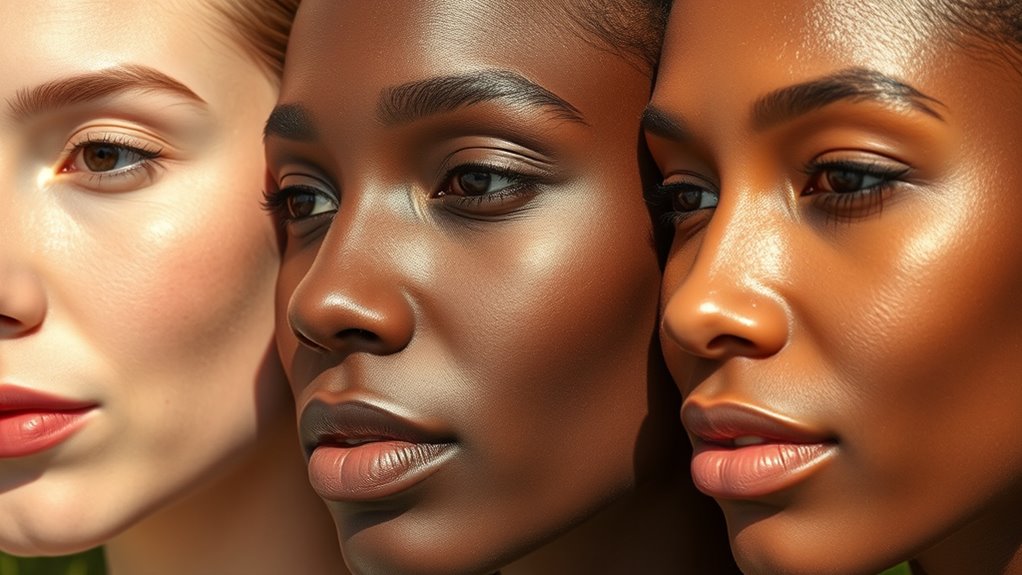
Taking proactive steps to care for your skin over the long term can make a significant difference in maintaining its health and youthful appearance. Establish a gentle skincare routine with mild cleansers to prevent dryness, and moisturize regularly to keep your skin hydrated and elastic. Incorporate vitamin C and retinol to improve texture and reduce aging signs. Exfoliate gently to remove dead skin cells and promote brightness. Daily application of broad-spectrum SPF 30+ sunscreen is essential, even on cloudy days, and reapply every two hours or after sweating. Support your skin from within with a balanced diet, hydration, sufficient sleep, and stress management. Protect your skin from environmental damage by limiting pollution exposure, avoiding harsh chemicals, and shielding against extreme weather conditions for long-term skin health.
Frequently Asked Questions
Can I Tan if I Have Very Fair Skin?
Think of your skin as a delicate canvas, easily damaged but capable of beautiful art. If you have very fair skin, you can tan, but it’s a slow, cautious process. Short, consistent sun exposure helps, but always prioritize protection to avoid burns. Using tanning activators or self-tanners can give you an even glow without risking damage. Patience and smart choices will help you achieve a healthier, safer tan.
Why Don’T Darker Skin Types Show Visible Tans?
You notice that darker skin types don’t show visible tans because of their high melanin levels. Your skin already contains a lot of pigment, so additional melanin production from sun exposure doesn’t create a dramatic change. While your skin still tans, it’s less noticeable. The increased melanin provides natural protection against UV rays, reducing redness and burns, but it also means tanning appears subtler compared to lighter skin.
Is It Possible for Dark Skin to Burn?
Yes, dark skin can burn, even though it’s less common and less visible. You might not see redness, but UV exposure can cause damage, increasing your risk for sunburn, pigmentation changes, and long-term skin issues. It’s important to use sunscreen and protective clothing, especially during peak sun hours. Don’t assume your skin can’t burn—taking precautions helps prevent damage and keeps your skin healthy.
How Long Should I Expose My Skin to the Sun Safely?
They say “a little goes a long way,” and that’s true for sun exposure. To stay safe, limit your time based on the UV index: about 15-25 minutes at UV 8–10, and less if it’s higher. Always wear sunscreen, especially SPF 30 or more, and seek shade during peak hours. Remember, gradual exposure helps your skin adapt without risking burns. Safety always comes first.
Can I Develop a Tan Without Sun Exposure?
Yes, you can develop a tan without sun exposure by using sunless methods. Topical self-tanners, spray tanning booths, and tinted moisturizers give you a natural-looking glow without UV damage. Dietary supplements rich in carotenoids and antioxidants can also enhance your skin tone gradually. These options offer safer, customizable alternatives that help you achieve a tan year-round while protecting your skin from harmful sun rays.
Conclusion
Understanding your skin type helps you tan safely and avoid damage. Did you know that about 80% of visible skin aging is caused by sun exposure? By recognizing your skin’s unique traits, you can enjoy the sun responsibly and protect your skin’s health long-term. Remember, everyone’s skin reacts differently, so tailor your sun protection strategies accordingly. Stay informed, stay safe, and embrace healthy tanning habits for radiant, protected skin.
